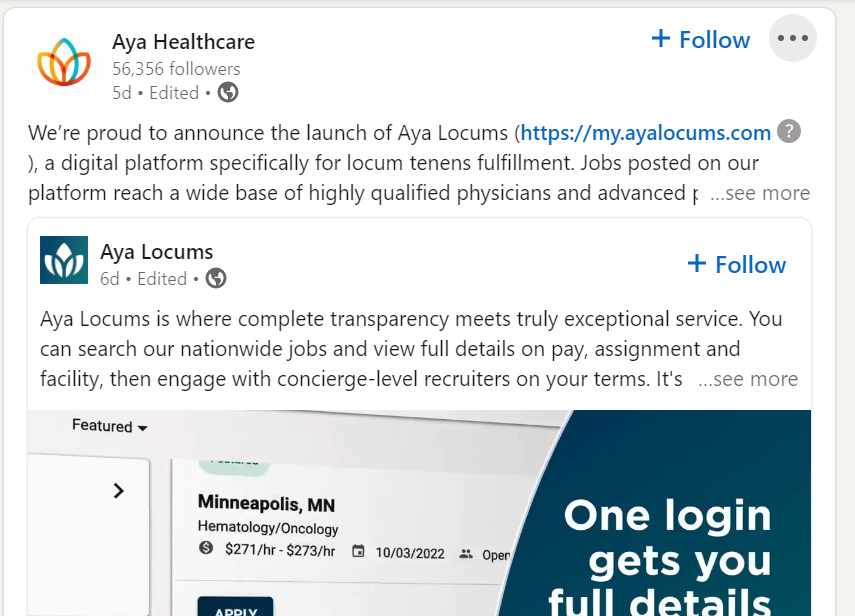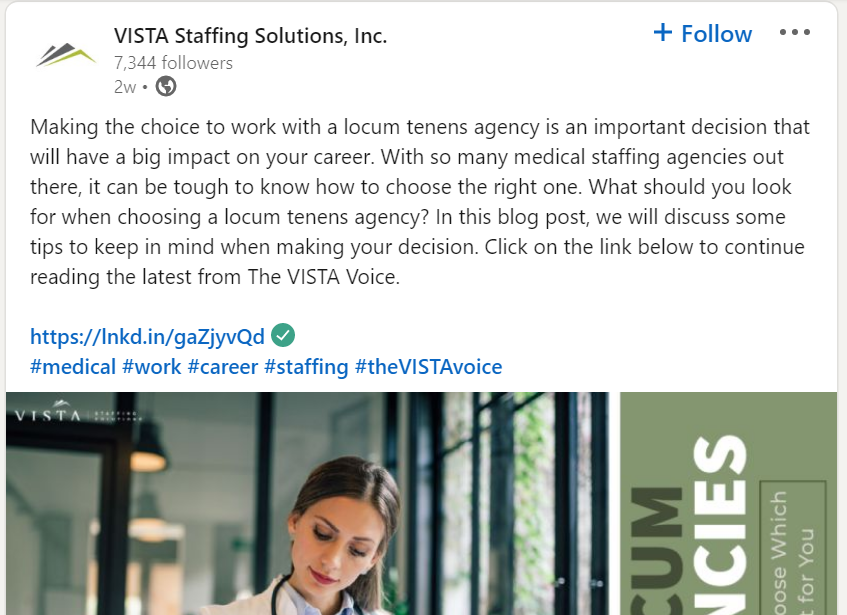In This Issue:
- How NALTO Helps Locum Tenens Physicians: An Interview with NALTO President-Elect Jarin Dana
- Floyd Lee Locums Keeps Winning
- Locum Tenens Physician Named 2023 National Staffing Employee of the Year
- Doctor Wait Times Average Almost Four Weeks In Big Cities
- Cross Country Healthcare to Acquire Assets of Mint Medical Physician Staffing, LP, And Lotus Medical Staffing LLC
- Physician Burnout Continues at Record Levels; One-Third Feel ‘Hopeless’
- How to Help Primary Care Physicians Craft Sustainable Careers
- Overcoming Barriers to Digitally Enabled Mental Healthcare Integration
- Socially Speaking: Social Posts of Note from LinkedIn, Twitter and Facebook
- ‘The pandemic is over,’ Biden says
- Hospital Margins Worse Than When Pandemic Began, Report Says
How NALTO Helps Locum Tenens Physicians: An Interview with NALTO President-Elect Jarin Dana
(Edited from AndrewWilner.com, 9/18/2022)
On Sunday, September 18, Dr. Andrew Wilner, FACP, FAAN, interviewed incoming NALTO® President Jarin Dana for his video blog entitled “The Art of Medicine.” Dana co-founded, and serves as chief financial officer for, Fusion Healthcare Staffing in Sandy, Utah.
Just about a week before NALTO’s annual Fall Fly-In, Dana talked with Dr. Wilner about the current landscape of locum tenens staffing, which has grown rather dramatically over the past couple of years.
In its August 11 Healthcare Staffing Report, Staffing Industry Analysts explained, “The past two years have brought unprecedented growth in the US healthcare staffing industry, as healthcare providers have turned to staffing suppliers for help with crisis needs related to the pandemic and also as a vital source for workers in an environment where job openings far exceed the supply of readily available candidates.”
Currently, more than 50,000 physicians take advantage of locum tenens assignments annually. Dr. Wilner himself works locum tenens in addition to his full-time position as associate professor of neurology at the University of Tennessee Health Science Center in Memphis, TN.
Speaking with Dr. Wilner, Dana explained NALTO’s role as a voluntary membership organization for staffing agencies that sets high ethical standards and practices for the locum tenens industry.
“NALTO–the National Association of Locum Tenens Organizations–is an industry association, started in 2001, that looks to create and enforce strong industry standards for the locum tenens industry,” Dana said.
“We stress things like honesty, objectivity, integrity and competency across our member firms,” Dana continued. “Our goal is to set clear and effective parameters of behavior for all individuals affected by the industry–like physicians and clients [healthcare facility staff] and the patients they serve, which is the ultimate goal of all of this.”
The incoming NALTO president said the main attraction of locum tenens for physicians, or other advanced practitioners, is the flexibility it allows. These healthcare providers can work with an agency recruiter to take assignments where, when and for what duration they choose, ‘allowing them to check out new locations and earn extra money to help pay back school loans,’ Dana said.
While locum tenens clinicians are independent contractors for income tax purposes, they can rely on most staffing agencies to provide medical liability coverage and to take care of travel arrangements and other administrative details, Dana noted.
NALTO is the only professional association for staffing firms placing ‘temporary physicians’ in healthcare facilities across the country. Dana said the group currently has 83 member firms and four affiliate members. Learn more about NALTO here.
Dana can be reached at www.fusionhcs.com.
Dr. Wilner said he was delighted to learn that Dana had read his book, The Locum Life: A Physician’s Guide to Locum Tenens, and that he recommends it to his colleagues.
You can listen to this and other episodes of “The Art of Medicine with Dr. Andrew Wilner” on the web or on your favorite podcast player.
All News Is Locums
Floyd Lee Locums Keeps Winning
(Edited from company news release dated 8/31/2022)
South Carolina-based Floyd Lee Locums has been ‘on a roll’ lately, adding two statewide accolades to its resume.
The company was named the “Grand Prize Winner” of SC Biz News’ “Best Place to Work in South Carolina” in the medium-sized employer category. Meanwhile, CEO Natasha Lee received Charleston Business Magazine’s 2022 South Carolina “Women in Business Award.”
“I know our ‘true north’ is the healthcare providers and the patients they care for. To do that, we need to hire and retain extraordinary talent and be a leader in our industry,” Lee said. “These awards indicate we’re on the right track.”
In the last year, the organization has been ranked on several award lists, including Staffing Industry Analysts’ “Best Staffing Firms,” Inc. 5000’s “Fastest Growing Companies,” and The Financial Times “Americas’ Fastest Growing Companies 2022.” Similarly, Lee continues her own streak of recognition, adding this to her most recent award on Staffing Industry Analysts’ “Global Power 150 List.”
In its 17th year of recognizing South Carolina businesses SC Biz News and the Best Companies Group acknowledged 119 companies—from contractors to credit unions. SC Biz News awarded three grand prize winners in their large, medium, and small employer categories; Floyd Lee Locums won the mid-sized honors.
Charleston Business Magazine recognized 54 women in this year’s “Women in Business Awards,” honoring them at an August 3 event at the Poinsett Club in Greenville, SC,
To see the full list of “Best Places to Work in South Carolina,” visit here. Learn more about the South Carolina “Women in Business Awards” here.
Locum Tenens Physician Named 2023 National Staffing Employee of the Year
(Edited from American Staffing Association news release, 9/12/2022)
The American Staffing Association recently announced it has made LocumTenens.com‘s Miechia Esco, MD, the 2023 National Staffing Employee of the Year. The announcement marked the beginning of National Staffing Employee Week, which ran from September 12 to 18 this year to celebrate the contributions of the millions of temporary and contract employees hired by US staffing agencies each year.
“From entry-level roles to the c-suite, temporary and contract employees are making a difference in our society and our economy,” said Richard Wahlquist, president and chief executive officer of ASA. “This year’s National Staffing Employee of the Year and All-Stars stories exemplify the ways staffing agencies help people of all ages and at all stages of their careers gain access to new and meaningful employment opportunities.”
National Staffing Employee of the Year | Healthcare Sector All-Star
Miechia Esco, MD
LocumTenens.com

A vascular surgeon, Miechia Esco, MD, looked to staffing to regain her passion for medicine. After starting to feel detached from the communities Dr. Esco served, she connected with a recruiter from LocumTenens.com and agreed to embark on a locum tenens contract.
Her subsequent newfound ability to choose when and where she works has reinvigorated her love of medicine, allowing her to travel to underserved communities where she is most needed. In addition to her locum tenens role, she serves as the agency’s chief medical resource adviser, a position created for her after she identified gaps across the healthcare staffing industry.
Practicing locum tenens medicine also gives Esco greater flexibility in how she spends her time outside the hospital. In addition to serving on medical mission trips, she’s become a certified yoga teacher and a world traveler who’s even conquered Mount Kilimanjaro.
The American Staffing Association is “the voice of the US staffing, recruiting, and workforce solutions industry. ASA and its state affiliates advance the interests of the industry across all sectors through advocacy, research, education, and the promotion of high standards of legal, ethical, and professional practice.” For more information about ASA, visit americanstaffing.net.
The Healthcare Staffing Story
Doctor Wait Times Average Almost Four Weeks In Big Cities
(Lightly edited from Forbes story by Bruce Japsen, 9/12/2022)
Patients are waiting an average of 26 days for a scheduled appointment with a doctor, according to a study of commonly used specialty physicians in 15 major US cities.
The survey by Merritt Hawkins, a unit of healthcare staffing firm AMN Healthcare, polled more than 1,000 physician offices looking at average wait times among family medicine, dermatology, obstetrics/gynecology, orthopedic surgery, and cardiology.
The average wait time is up 8% from 24.1 days in 2017, “the last year the survey was conducted, and up from 21 days in 2004, when the survey first was conducted,” according to Merritt Hawkins and AMN Healthcare.
“Physician appointment wait times are the longest they have been since we began conducting the survey,” Tom Florence, president of AMN Healthcare’s physician search division said in a statement accompanying the report. “Longer physician appointment wait times are a significant indicator that the nation is experiencing a growing shortage of physicians.”
Urban Wait Times as a Bellwether
Though the analysis looked at major US cities, the wait times are likely worse elsewhere in the country given large markets tend to have more physicians because they are home to academic medical centers and high concentrations of healthcare facilities generally.
“It’s a sobering sign for the rest of the country when even patients in large cities must wait weeks to see a physician,” Florence said.
The Biden administration late last year moved to fund an additional 1,000 physician residency slots over the next five years to “address access to care, workforce shortages in high-need areas.” It will take several years, however, for those residents to have an impact on appointment times in the US, analysts say.
Meanwhile, health insurers are pushing more of a team-based approach to healthcare to keep a lid on healthcare costs as the population ages, with the federal government shifting more commercial, Medicaid and Medicare dollars away from fee-for-service payment to value-based care models.
But most of the new models use a physician as a quarterback even as doctors, retail clinics, and other health systems are handing off more responsibilities to physician assistants and nurse practitioners.
Here are some other highlights of the survey, which looked at wait times in Atlanta, Boston, Dallas, Denver, Detroit, Houston, Los Angeles, Miami, Minnesota, New York City, Philadelphia, Portland, San Diego, Seattle and Washington, DC:
- “The average wait time for an OB/GYN appointment in the 15 cities surveyed is 31.4 days, up 19% from 26.4 days in 2017.”
- “Average orthopedic surgery wait times are longest in San Diego at 55 days and shortest is Washington, DC at five days.
- “Average dermatology wait times are longest in Portland at 84 days and shortest in Philadelphia at nine days.”
- “Average cardiology appointment wait times are longest in Portland at 49 days and shortest in Dallas at 13 days.”
Cross Country Healthcare to Acquire Assets of Mint Medical Physician Staffing, LP, And Lotus Medical Staffing LLC
(Edited from BusinessWire, 9/13/2022)
Cross Country Healthcare, Inc. (“Cross Country,” Nasdaq: CCRN) has announced plans to acquire the assets of Mint Physician Staffing, LP (“Mint”) and Lotus Medical Staffing LLC (“Lotus”). The transaction is expected to close in the last quarter of 2022.
Mint is a Houston-based locum tenens staffing agency, while Florida-based Lotus is a locum tenens and permanent placement agency specializing in the placement of anesthesiologists and certified registered nurse anesthetists (CRNAs). Both sellers staff throughout the United States.
“As the first acquisition in 2022, we are thrilled to be adding the Mint and Lotus brands to our portfolio, which supports our strategy of becoming a dominant player in the locum tenens and advanced practitioner markets,” Cross Country President and CEO John Martins said.
Cross Country Healthcare, Inc. (CCH) is a leading tech-enabled workforce solutions and advisory firm with 36 years of industry experience and insight. The company’s locum tenens business line has been certified by the National Committee for Quality Assurance (NCQA), the leader in healthcare accreditation, since 2001. Cross Country still holds a Letter of Distinction as the first publicly traded staffing firm to obtain The Joint Commission Certification.
Physician Burnout Continues at Record Levels; One-Third Feel ‘Hopeless’
(Edited from MedPage Today article by Shannon Firth, 9/19/2022)
The state of physician well-being remained low two years into the pandemic, according to recent survey data. One in three physicians reported feeling hopeless or that they had no purpose, according to the second part of the 2022 Survey of America’s Physicians from the nonprofit Physicians Foundation.
For the second year in a row, 60% of 1,509 physicians who completed the online survey said they often feel burned out, compared with 40% before the pandemic.
“Burnout remains at record levels despite the worst parts of the pandemic being behind us,” Physicians Foundation President Gary Price, MD, said in an email to MedPage Today.
“Physician burnout has not gone unnoticed by our profession or by society, and yet what we found most equally concerning is that there is still rampant stigma surrounding seeking mental healthcare and that underlying system barriers are preventing physicians from accessing mental healthcare,” he observed.
The share of physicians with self-harm thoughts grew from 7% in 2021 to 11% in 2022, the study found. Overall, 19% sought medical attention for a mental health problem, up from 14% in 2021.
Stigma Still Exists
“We knew stigmatizing and intrusive mental health questions on medical licensure and hospital credentialing applications was a barrier, but the survey reinforced how bad it is,” Price said.
“Nearly four in 10 physicians were either afraid or knew another physician fearful of seeking mental healthcare because of questions asked in medical licensure, credentialing, or insurance applications,” he pointed out.
In all, 80% reported stigma surrounding mental health and mental-healthcare-seeking by physicians.
Survey responses also showed:
- 58% of physicians experienced inappropriate anger, tearfulness, or anxiety
- 46% have withdrawn from family, friends, and co-workers
- 17% increased use of medication, alcohol, or illicit drugs
- 11% began use of medications, alcohol, or illicit drugs
In the past year, a higher percentage of employed physicians, physicians 45 and younger, and female physicians had inappropriate feelings of anger, tearfulness, or anxiety; withdrew or isolated themselves from family, friends, and co-workers; and felt hopeless or that they had no purpose.
“For too long, there has been an assumption that physicians just need to be more resilient, and approaches to eliminating burnout have focused on this,” Price said.
Employer Helpfulness Remains Low
About two in 10 physicians found their hospital or health system to be “very or somewhat” helpful to their mental health and well-being over the past year. Four in 10 physicians saw their medical practice or group as “very or somewhat” helpful.
By contrast, a majority of physicians rated family (85%), friends (81%), and colleagues (62%), as helpful to their mental health and well-being.
In his email, Price highlighted five evidence-based actions from the nonprofit All-In coalition that could be initiated within three months to help physicians and other healthcare workers.
Peer support programs and mental health counseling were among those actions. In the Physician Foundation’s survey, 65% of respondents reported that confidential therapy and counseling or phone support was “very or somewhat” helpful and 57% said they felt the same about peer support groups.
More than half of physicians said their workplace “rarely or never” implemented a majority of evidence-based actions intended to support physicians, such as removing low-value work, giving physicians more flexibility and autonomy to improve the patient experience, and eliminating insurance approvals.
A recent analysis conducted by the All-In group found that 17 states have removed “intrusive mental health questions” as of August 24, but another 33 states and the District of Columbia have not, Price noted.
Methodology Explained
The survey was conducted from June 24 to July 3, 2022, following emails to physicians using a Medscape database. The sample represents the site’s online population with a margin of error of ±2.523% at a 95% confidence level.
Approximately 42% of respondents were women and 58% were men. Most (57%) were specialists, while 43% were primary care physicians. Half of respondents were 36 to 55 years old. About half (51%) were employed by a hospital, 20% worked for a physician-owned medical group, and 23% were independent.
How to Help Primary Care Physicians Craft Sustainable Careers
(Excerpted & lightly edited from Harvard Business Review article by Timothy Hoff, 9/19/2022)
Physician burnout, particularly in primary care, receives much attention these days. However, burnout among primary care physicians (PCPs) is a symptom of a bigger issue: the need for healthcare organizations to help them build sustainable careers.
The US primary care system is undergoing major change. Companies like Apple and Amazon continue their slow-but-steady march into the primary care space. Big hospital systems use primary care services as loss leaders for higher-cost specialty care. And primary care physicians continue to disappear from the landscape.
The stage is set for a wholesale transformation of primary care—and perhaps after that all of healthcare—into something less physician-centric and more transactional and technological.
How will PCPs survive and thrive in such a reality? How can they balance some loss of traditional professional identity with new identities that help them navigate uncertain and fluid work situations? What will end up as their “typical” career trajectories in this new world? How can the industry make sure they remain engaged in their work?
Trend Has Been Growing
I have interviewed hundreds of primary care physicians (PCPs) in my research over the years. Many of them have seen this day coming for a while for these reasons.
There has been a steady erosion of primary care physician work, making the everyday job of a PCP more routine and less autonomous. This is especially true when the physician is a salaried employee rather than a practice owner, with more doctors than ever now working for someone else. For example:
- There has been a continuing decrease in medical students picking primary care as their career specialty.
- The healthcare industry has devalued PCPs as clinicians, turning them into paper pushers and goodwill ambassadors for larger corporate healthcare brands.
- Their workloads continue to increase, impacting their ability to forge trusting relationships with their patients.
This perfect storm of circumstances has left too many primary care physicians worn down and dissatisfied.
Many PCPs with whom I have spoken over the past decade have told me about a general malaise they feel. For them, it starts and ends with what they perceive as a general degradation of their status as professionals and experts. No one seems to be paying attention to them.
Everyone thinks they are invincible in their capacity for working long hours and putting up with poor job conditions. They lament that their employers see them only as high-cost cogs in the production process and want them to move their patients through the daily treadmill as efficiently as possible. They feel less empowered to control their fates.
Dealing with this malaise starts with sustainable career building, and a big component of that is effective career crafting. Neither of these things has been talked about much with doctors. But they are at the root of cultivating a stronger and more resilient PCP workforce. Here are four ways healthcare employers can facilitate the PCP career-crafting endeavor:
1. Hire PCPs for fit.
Physicians are rarely treated as individual talent by their employers. The “MD” or “DO” initials create a widespread perception that they all think the same way, but they don’t. Employers should take that into account in hiring.
- First, healthcare employers should implement hiring assessments to identify what prospective job applicants prioritize in their jobs and careers. They should not simply throw a net out into the waters and hire any PCP that gets caught in it.
Second, they might approach PCP recruitment the way top tech firms like Google do when recruiting talent: by striving to fit the applicants to the type of jobs and work (and workplaces) in which they will engage.
For instance, some PCPs may want to do more telemedicine than in-person care; others the opposite. Some may want to share their job with another PCP. Some may like routine work that is interesting, while others may wish for more complex work that carries a higher stress workload.
Fitting the PCP to the job and work that suits them helps these doctors craft careers that they feel in control of, keeps them invigorated, and leaves them feeling better about their employer.
Third, let the physician assume significant control over the job-fit process. In this way, healthcare employers could learn from the concept of locum tenens, in which physicians work on contract for different employers, and are driven by individual preferences for different job rewards and job structures.
The general principle inherent in locum tenens recruitment—the employer is highly specific about what the job entails and offers and then lets physician applicants seek out the fit according to their personal wants and needs—can be applied to all types of PCP jobs.
2. Emphasize work-life balance in every PCP job and workplace.
Primary care physicians, particularly younger ones, want work-life balance. Healthcare employers can make that happen in several ways:
- Rid the PCP job of excessive administrative demands.
Whatever can be done to save the PCP time and aggravation should be promoted. Ways to do this include hiring scribes that reduce PCP documentation time and reducing the number of quality metrics that physicians need to report on for each patient. The overabundance of quality reporting disrupts PCP workdays and often serves to placate the documentation requirements of the health insurer rather than add value to the patient visit. - Set strict weekly work-hour limits.
Doing direct patient care for eight hours a day is difficult enough. But PCP workdays often contain too many administrative tasks, as noted, and just one or two unpredictable patient visits can produce additional hours of work that bleed into the early morning or late evening. Healthcare employers should treat PCPs in the same way airlines treat their pilots. After a set number of work hours each week, they must stop working completely for a period of time. - Use electronic health record systems to foster cross-team communication and collaboration.
EHR systems that streamline documentation tasks and facilitate real-time communication among the members of a primary care team are imperative: It allows care work to be transferred more quickly across the team and practice, easing the PCP’s workload when needed. - Tie a portion of pay to non-clinical accomplishments.
For example, an employer might base some portion of PCP raises and promotions on factors that include how PCPs contribute to advancing community or public health in their spare time. This conveys that the employer cares about the PCP’s interests in fulfilling all elements of his or her generalist doctor role.
3. Promote professional development.
Many PCPs don’t want to see patients full-time in a clinical setting forever. This is a natural inclination given how hard the job of direct patient care is day in and day out. Healthcare employers should assume this inclination exists for all PCPs and act accordingly in the way they facilitate career development for this group.
Assume many PCPs are interested in learning skills related to what may start as side hustles but blossom into more over time. These include engaging in public and community health activities; doing nonprofit work; learning niche areas of primary care such as hospital medicine, geriatric care, and emergency medicine; becoming medical educators; and getting involved in health policy and advocacy.
Then provide time off and financial support for them to pursue formal training in these areas and create opportunities in their existing jobs to gain real-world experience doing them. Create attractive job titles which embody these opportunities that go beyond the generic title of “primary care physician.” If you’re a big health system, encourage PCPs to seek out and apply for these jobs in your own backyard.
4. Let PCP teams craft their members’ jobs.
There has been a growing recognition that taking a team approach to primary care—where multiple PCPs work together collaboratively—not only can improve the quality of care but also can foster an esprit de corps among PCPs that bonds them closer together.
Let the PCPs on a team figure out how best to share their workload, plan their work schedules, figure out what they each are good at and want to do clinically, and support each other. Incentivize the PCP team to figure out the best way to deliver care to their patient panels while giving team members the ability to create personally rewarding experiences for themselves. Make the clinical team even stronger by letting it self-manage more.
Burnout is a symptom of the larger malaise afflicting primary care physicians today. Address the malaise by enabling PCPs to build sustainable careers and the burnout problem will shrink. Happier PCPs will emerge—physicians who will be more likely to lead and be led.
There are certain emerging realities about how the US primary care system soon will look that must be accepted by primary care physicians. The bigger questions now for primary care doctors who plan to work in that system are (1) How will they adapt to these realities? and (2) What will their employers do to make that adaptation successful?
Tools to Try/News to Use
Overcoming Barriers to Digitally Enabled Mental Healthcare Integration
(Lightly edited from AMA Digital article by Tanya Albert Henry, 9/6/2022)
The number of patients who need access to mental health services is growing, yet there continues to be a shortfall of health professionals who can meet that demand.
Nearly 40% of American adults reported depression and anxiety symptoms in 2021, far higher than the 10% who reported those symptoms just three years earlier. And in 2020, 71% of parents told researchers that they believed the COVID-19 pandemic impacted their children’s mental health.
Behavioral health integration (BHI) will be essential in easing the nation’s mental health crisis and incorporating digitally enabled care into BHI can help physicians reach even more people in need of care, experts from the AMA and Manatt Health said during a recent AMA webinar.
They discussed the opportunities and limitations of using technology to support BHI, as well as solutions to help address areas that are preventing more physicians from adopting BHI. The information is explored in even more depth in the organizations’ joint report, Accelerating and Enhancing Behavioral Health Integration Through Digitally Enabled Care: Opportunities and Challenges (PDF).
Leaders from three other organizations shared how they’ve put digitally enabled BHI into action across the country.
“All stakeholders across the board…really have to work together to make digitally enabled BHI a standard across the country,” Christopher Botts, the AMA’s senior manager, care delivery and payment, said during the webinar. “There is also a general recognition that digital tools…[can] accelerate BHI adoption and help remove barriers that have existed over the past several years.”
Defining Opportunities, Limitations
During the webinar, Botts discussed the opportunities and limitations of using technology to support BHI.
Among the opportunities:
- Enhanced patient management and treatment.
- Support for care integration.
- Limited care fragmentation.
- Generated value for patients and providers.
In addition, the AMA Return Health Framework can help measure BHI’s value for your practice.
Among the limitations:
- Technology won’t completely replace in-person interactions or patient assessments
- Robust clinical or economic evidence isn’t there yet to support major regulatory and coverage decisions.
- Technology within BHI is not clinically appropriate for, or available to, all people.
- Patients, physicians, and health professionals may not be able to use technology effectively based on personal preferences, in addition to potential gaps in digital literacy and or broadband access.
Breaking Down Barriers
Jared Augenstein, Manatt Health’s Director, shared ways for various groups in the healthcare system to address gaps hindering BHI’s widespread adoption.
For example, physician practices and health systems can:
- Increase diagnosis and treatment rates by incorporating evidence-based digital solutions into standard workflows.
- Implement technologies that facilitate care coordination and enable highly collaborative care.
Health plans and coverage programs can:
- Expand coverage and fair payment with a margin for all stakeholders using BHI models.
- Evaluate how and when to apply cost-sharing for integrated services, whether delivered in person or via telehealth.
- Minimize or eliminate utilization management practices for BHI services.
Federal and state policymakers can:
- Work with health plans and coverage programs to limit utilization management review practices, enforce behavioral health parity laws and strengthen network adequacy regulations.
- Increase federal funding with the aim of growing the behavioral health workforce, especially for those practicing in underserved areas.
Telehealth is critical to the future of healthcare, which is why the AMA continues to lead the charge to aggressively expand telehealth policy, research, and resources to ensure physician practice sustainability and fair payment.
Check out the BHI Collaborative’s Behavioral Health Integration Compendium, which provides healthcare organizations with a proven pathway for delivering integrated behavioral healthcare and ensuring they have the most recent, actionable information at their disposal.
Socially Speaking
From Linkedin



From Twitter
From Facebook/Instagram
How ‘Bout This?
‘The pandemic is over,’ Biden says
(Edited from Becker’s Hospital Review, 9/19/2022)
President Joe Biden said the COVID-19 pandemic is “over” in the United States in an interview on CBS News’ 60 Minutes that aired Sept. 18.
“The pandemic is over. We still have a problem with COVID. We’re still doing a lotta work on it,” President Biden said in the interview, which was conducted as he walked the floor of the Detroit Auto Show last week. “But the pandemic is over. If you notice, no one’s wearing masks. Everybody seems to be in pretty good shape. And so I think it’s changing.”
Fewer than 70,000 coronavirus cases are currently announced each day in the US, the lowest level seen since early May, and fewer than 35,000 people are currently in American hospitals with COVID-19 daily. The daily average number of deaths from COVID-19 was 464 at the time the president’s interview aired, according to data from The New York Times.
The president’s declaration followed the World Health Organization’s signaling of the pandemic’s wind-down with new weekly COVID-19 deaths at their lowest point globally since the start of the pandemic. “We have never been in a better position to end the pandemic,” WHO Director-General Tedros Adhanom Ghebreyesus, PhD, said on Sept. 14. “We are not there yet, but the end is in sight.”
Policywise, HHS is still set to extend the COVID-19 public health emergency by its standing deadline of Oct. 13. This would make for the 11th renewal of the PHE since its declaration in January 2020 by former and current HHS secretaries Alex Azar and Xavier Becerra, respectively.
The renewal would occur as HHS plans to shift costs of COVID-19 vaccines and treatments to the commercial market, a process beginning this fall that is expected to take months.
Hospital Margins Worse Than When Pandemic Began, Report Says
(Edited from Healthcare Dive, 8/30/2022)
Dive Brief:
- Hospitals’ outpatient volumes and operating room times both declined in July compared to June, while costly inpatient stays lengthened. The combination is contributing to some of the worst operating margins since the start of the COVID-19 pandemic, Kaufman Hall said in a report published Monday.
- Pent-up demand for medical care that was postponed during the winter surge in COVID-19 omicron cases has bottomed out, the advisory firm said. At the same time, Coronavirus Aid, Relief, and Economic Security Act and stimulus funding that helped offset losses in previous pandemic years has dried up.
- Kaufman Hall said its median hospital operating margin index of negative 0.98% for the year to date reflects seven straight months of losses. “July was a disappointing month for hospitals and put 2022 on pace to be the worst financial year hospitals have experienced in a long time,” said Erik Swanson, senior vice president of data and analytics.
Dive Insight:
Kaufman Hall’s newest monthly update on national hospital performance is the latest grim assessment of the sector’s withering finances.
A string of healthcare systems have reported weak results in the first half of the year, exacerbated by labor shortages and rising supply costs that are driving up expenses. Against this backdrop, Fitch Ratings earlier this month revised its outlook for the US nonprofit hospital sector to “deteriorating.”
The American Hospital Association, in its own report, said hospitals are treating sicker patients who delayed care earlier in the pandemic, and the higher acuity rates are placing a greater burden on staff and creating “unsustainable” financial challenges.
Kaufman Hall said its findings support the conclusion that sicker patients are seeking treatment at hospitals. The average length of stay increased 2% in July from June and 3.4% from July 2021. Patient days rose 2.8% from the prior month, and emergency department visits increased 2.6%.
However, operating room minutes dropped 10.3% in July from June. The drop in outpatient and surgical revenues is part of a larger shift in the way patients are accessing care, more often choosing ambulatory centers over hospital settings as the place to have procedures, Kaufman Hall said. Outpatient revenue dropped 4.8% from June.
Labor expenses, which have remained well above pre-pandemic levels throughout 2022, jumped in July from June, the report found. Labor expense per adjusted discharge rose 3.5% from June and has climbed 14% year to date.
Hospitals’ total expenses dipped 0.4% from June but were up 7.6% from July 2021. Inflation and labor shortages contributed to total costs increasing 9.6% year-to-date, the report said.








